UNIT 3



Ragtime
-
1.Background and Origins
-
a.Syncopation had already been featured in the songs and dances of the post-war minstrel show.
-
b.After the Civil War, many black pianists were playing syncopated music, especially in the Midwest and on the East Coast.
-
c.But it wasn’t until the piano rags of Scott Joplin (see photo at right) that syncopation would become an important feature in popular music.
-
d.Ragtime would flourish from the last years of the 19th century until just after World War I, when jazz would take over.
-
2.Scott Joplin (1868-1917)
-
a.Born in Arkansas, settled in Missouri, and eventually went to New York City.
-
b.Trained as a classical pianist and composer, but also played cornet and led a band.
-
c.Published his first piano “rag” in 1899, followed by many others (see “Wall Street Rag” at right).
-
d.Also wrote a ballet and two operas (one is lost).
-
3.The sound of the piano rag
-
a.Syncopated melody in the right hand, against a steady march-like beat in the left hand.
-
b.Moderate tempo--Joplin warned against playing his rags too fast.
-
c.The form is close to that of the march with repeated sections. Compare the Listening Cue in your text for Joplin’s “Maple Leaf Rag” to that for Sousa’s “Stars and Stripes Forever.”
-
d.Ragtime represents an intersection between European (harmonies, march form, use of piano) and African (complicated, syncopated rhythm) styles.
-
-
-
-
-
-
-
-
-
5.Rag enters pop culture
-
a.Initially a piano piece, rag soon came to mean any syncopated music. Sometimes pieces that were hardly syncopated at all included “ragtime” in the title, for example “Alexander’s Ragtime Band” (see sheet music at right).
-
b.As ragtime became popular, it met with resistance because it was associated with saloons and brothels, where it was often played.
-
c.It also faced prejudice, because it was considered a black musical style.
-
4.The legacy of ragtime
-
a.Musical legacy
-
1)Ragtime has lasted because it is a serious artistic style. Joplin believed that he had elevated the folk dance to the concert hall (as Chopin had done with the mazurka).
-
b.Responsible for some “firsts”:
-
1)The first true musical mixture of European and African-American styles. (Minstrelsy had mixed African-American idioms with folk styles.)
-
2)The first time that many African-Americans became aware of their own culture. This encouraged other black artists (for example, W. C. Handy) to preserve their musical heritage.
-
3)The first time African-American music was published and disseminated to a wide audience. Many composers followed Joplin’s lead in publishing rags, which became a big business for music publishers.
-
c.Impact on later styles
-
1)Shaped jazz in the early years. Piano rags influenced famous jazz pianist “Jelly Roll” Morton to actually become a pianist;
-
*Listen to Morton’s “Maple Leaf Stomp,” a jazz arrangement of Joplin’s “Maple Leaf Rag.”
-
2)Led to a new freedom in popular song;
-
3)Influenced some classical composers, such as Claude Debussy and Paul Hindemith.
Syncopated Dance Music
-
1.Ragtime dance
-
a.Ragtime soon became music for social dancing. Other dances followed, some named for animals, such as the grizzly bear and the turkey trot (see the dancers in the photo at right).
-
b.Some dances were outlawed in various places because of the loose clothing worn by women and the body contact between dancers.
-
c.Eventually the foxtrot would emerge as a more refined “animal dance.”
-
4.James Reese Europe (1881-1919)--see photo at right below
-
a.Europe was an orchestral conductor and entrepreneur. His Europe’s Society Orchestra won national acclaim, and Europe was probably the most respected black musician in the US during his lifetime.
-
Notice Europe’s use of the word “orchestra,” rather than band. His group included strings (mostly violins), so the designation is warranted. Generally, a band does not have strings, whereas an orchestra does.
-
b.Europe composed syncopated dances for Vernon and Irene Castle, a popular dance couple of the day (see photo at right).
-
c.Europe popularized the foxtrot, a dance with two beats and a strong backbeat. Some of these are called rags, such as the “Castle House Rag” of 1914, but there are differences between Europe’s orchestral rags and Joplin’s piano rags:
-
1)Faster tempo;
-
2)Less syncopation (less rhythmic conflict between parts);
-
3)Chances for instrumentalists to improvise, as the drummer does near the end of “Castle House Rag.”
-
d.Soon white bands played syncopated dances, and the foxtrot became the most important social dance of the 1920s and 30s. Now dancing to a syncopated (“black”) beat had become acceptable.
Early Commercial Blues
-
1.Background
-
a.Blues originated in work songs and other music sung by slaves, which, in turn, had been influenced by African music, as we’ve already seen.
-
b.This type of folk blues, an oral tradition performed in rural areas well out of the mainstream (often in tent shows and on the vaudeville circuit), was not recorded until the mid-1920s. This non-commercial type of blues, which would be so influential on rock and roll and later styles, will be discussed in Unit 6.
-
c.The commercial version of the blues, which was published and recorded earlier, mixed blues elements with other styles for commercial purposes.
-
d.Commercial blues, especially as promoted by W. C. Handy (photo at right), mark the entrance of blues into the mainstream and shaped the sound of popular song in the early part of the century.
-
2.Blues in print and on recordings
-
a.Many instrumental blues pieces, especially those by W. C. Handy, were published around 1910 and recorded shortly afterwards.
-
b.These instrumental blues mixed blues elements with other styles, making the music popular with mainstream audiences.
-
c.Handy’s “St. Louis Blues” (1914) was the most frequently recorded “song” in the first half of the 20th century.
-
3.Classic blues
-
a.The blues recorded during the 1910s were instrumental pieces with no vocals (although later vocals were often added).
-
b.In 1920 Mamie Smith recorded “Crazy Blues,” actually a blues-influenced popular song.
-
-
c.The popularity of “Crazy Blues” encouraged record companies to look for other black singers who sang in the blues style. With the growth of commercial radio (which meant that people could listen to music for free), record companies needed to target audiences whose preferred music was not being heard on radio stations. This is discussed in Unit 4.
-
d.Black audiences were one of these, and “race records” filled this gap. At right, see an advertisement for Paramount Records, billed as “The World’s Best Race Records.” (White rural audiences were also targeted with “hillbilly music).
-
e.One of the most important blues singers who was recorded was Bessie Smith.
-
4.Bessie Smith (1894-1937)--see photo at right
-
a.Her recordings epitomize the classic commercial blues style; most of her songs mix blues with jazz and popular song styles.
-
1)Form:
-
a)12-bar blues, although some of her songs have other forms, especially the AABA form of 1920s popular songs (more on this form in Unit 4);
-
b)Call and response between Smith and the instrumentalists.
-
2)Singing style:
-
a)Personal touches; highly inflected style--almost sounds like speech intensified into song;
-
b)Rough, gravely voice;
-
c)Phrases that start high and end low.
-
3)Feeling:
-
a)Blue mood;
-
b)Racy metaphors.
-
b.“Empty Bed Blues” (1928)
-
-
-
-
c.Bessie Smith appeared in a short film in 1929, St. Louis Blues, a very unusual occurrence for a black blues singer at this time.
-
*Watch this excerpt from the film, in which Smith sings Handy’s “St. Louis Blues.”
-
-
4.The legacy of blues style
-
a.Blues affected social dancing, popular song, jazz, and even musical theater. Click here for a song from a 1927 musical that has blues touches because the character who sings it, Julie, is bi-racial.
-
b.Blues put heart and soul into popular music.
Early Jazz
-
1.The roots of jazz
-
a.New Orleans, which had a diverse racial and ethnic population in the 2nd half of the 19th century, is regarded as the birthplace of jazz (see an early photo at right).
-
b.The black population itself was diverse and included ex-slaves as well as “Creoles of color,” who were better educated and lived in better neighborhoods.
-
c.But after the “Jim Crow” laws were enacted in 1892, all people of color were forced to live in the same area. This forced musically-uneducated street musicians to interact with classically-trained musicians, a situation that encouraged jazz to begin.
-
d.Jazz was a mixture of:
-
1)The feeling of blues and the spontaneous, improvisational spirit of the street musicians;
-
2)The virtuosity, harmonies, and discipline of classically-trained Creoles.
-
e.Most jazz musicians worked in Storyville (see an old photo at right), where prostitution was legal. When Storyville closed in 1917, musicians moved elsewhere, especially to Chicago.
-
2.The New Orleans jazz band (see a photo at right)
-
a.Standard instrumentation came from three sources:
-
1)Marching band: clarinet, cornet or trumpet, trombone, brass bass (tuba), drums;
-
2)Minstrel show and string bands: banjo and string bass;
-
3)Saloons and brothels: piano.
-
b.Two parts: frontline and rhythm section
-
1)Frontline: instruments that play the melody
-
a)In New Orleans jazz, frontline instruments play at the same time--”collective improvisation,” which means they make up the music as they went along.
-
b)But the organization is controlled within boundaries that the musicians understood (see. text for the “fast break” in basketball analogy).
-
2)The rhythm section marks the beat and supplies the harmonies. The standard rhythm section at this time comprised banjo, piano, tuba, and drums.
-
3.King Oliver’s Creole Jazz Band
-
a.Joe “King” Oliver (1885-1938)--see photo at right--was a famous bandleader and cornet player, who left New Orleans for Chicago. There he gathered several of his colleagues who had also moved there, to form his band.
-
b.“Dippermouth Blues” (1923)
-
1)Frontline: 2 cornets, clarinet, trombone
-
2)Rhythm section: piano (barely heard), banjo, drums, percussion
-
3)Blues song in style and feeling; instruments imitate the way blues singers bend pitches and slide into notes
-
4)Uses collective improvisation, while the rhythm section keeps time
-
5)Although there are a trumpet solo (Oliver) and a clarinet solo, no instrument really dominates.
-
*Listen to Oliver’s “Dippermouth Blues,” and follow the Listening Cue in the text.
-
-
-
4.The essence of jazz: swing and improvisation
-
a.Swing:
-
1)Rhythmic play over a 4-beat rhythm;
-
2)Swing represents a mixture of European and African rhythmic ideals. Swing keeps the time structure of European music but interpreted through African sensibility;
-
3)So, instead of accenting only the first beat of each bar, swing accents every beat. But there are also syncopated accents that conflict with the steady beat of the rhythm section.
-
b.Improvisation:
-
1)Creating music spontaneously, yet within a structure;
-
2)In New Orleans jazz the players participate in collective improvisation;
-
3)In later jazz styles, individual players would emerge from the group to play solos.
-
5.Louis Armstrong (1901-71)--see photo at right
-
a.Armstrong played cornet in King Oliver’s band and later in Fletcher Henderson’s band, before he went on to lead his own group.
-
b.He was the first great soloist in jazz; his playing is expressive in every way, and his exuberant sense of swing is incomparable.
-
c.“Hotter than That” (1927)
-
1)Frontline: clarinet, trumpet/voice, trombone;
-
2)Rhythm section: piano, banjo, guitar;
-
3)Improvised solos by each instrumentalist, with collective improvisation at the end;
-
4)Armstrong on trumpet, which mimics a voice, and “scat” singing, which mimics an instrument;
-
5)Rhythmic play among the group causing syncopation;
-
6)Form comprises several choruses.
-
*Listen to Armstrong’s “Hotter Than That,” and follow the Listening Cue in the text.
-
*Now listen again to Armstrong’s’s “West End Blues” from Unit 1.
-
-
6.Jazz during the 1920s
-
a.Jazz musicians began moving to northern cities, like Chicago and New York.
-
b.Record companies recorded both black and white jazz artists, making jazz a national style.
-
c.F. Scott Fitzgerald called the 1920s “The Jazz Age,” for it was an optimistic and exuberant decade, just like the music itself.
Looking Back, Looking Ahead
-
1.In the first 3 decades of the 20th century, black musical styles gradually gained an important place in American musical life.
-
2.Ragtime, syncopated dance music, blues, and jazz would eventually transform American popular music and bring it into the modern era.
Photos
-
1.“King” Oliver and His Creole Jazz Band
-
2.Bessie Smith
-
3.W. C. Handy
-
4.Louis Armstrong
-
5.“Jelly Roll” Morton
Unit Three
The Emergence of Black Music

The Emergence of Black Music


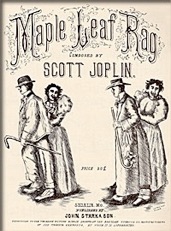
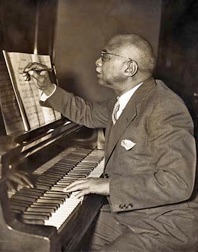
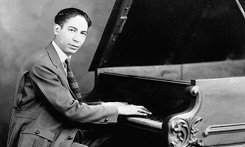






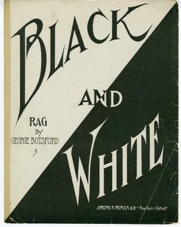










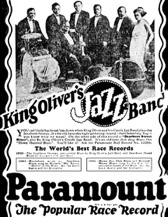


Another photo of King Oliver’s Band. Armstrong is 3rd from right.
New Orleans riverfront in the late 19th century
Scott Joplin
Cover of the sheet music for Joplin’s “Wall Street Rag”
Cover of the sheet music for Irving Berlin’s “Alexander’s Ragtime Band,” 1911
Cover of the sheet music for George Botsford’s “Black and White Rag,” 1908
A couple dancing the turkey trot
Vernon and Irene Castle, a dancing sensation in the early 20th century
William Christopher Handy
Storyville in the late 19th century
Sam Morgan’s Jazz Band
Joe “King” Oliver
Bessie Smith, “Empress of the Blues”
“Jelly Roll” Morton
James Reese Europe
Oliver’s Creole Jazz Band, with Louis Armstrong in front playing the slide trumpet. Notice the instruments.
Louis Armstrong

